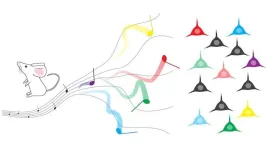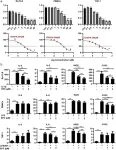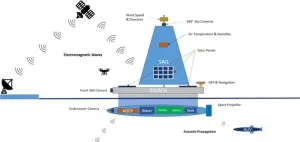(Press-News.org) The cerebral cortex is the largest part of a mammal’s brain, and by some measures the most important. In humans in particular, it’s where most things happen—like perception, thinking, memory storage and decision-making. One current hypothesis suggests that the cortex’s primary role is to predict what’s going to happen in the future by identifying and encoding new information it receives from the outside world and comparing it with what was expected to occur.
A new study published today in the journal Neuron takes a big step toward proving that hypothesis. The paper’s lead author is Yuriy Shymkiv, a postdoctoral fellow in the lab of Professor Rafael Yuste.
“We found that the cortex acts like a memory machine, encoding new experiences, and predicting the very near future,” Shymkiv said.
“This study gives a great deal of insight into the role of the cerebral cortex, and into diseases like schizophrenia where the cortex seems to be malfunctioning,” Yuste said, noting that it also helps clarify important processes in the normal brain. “Novelty is the difference between what you predicted will happen and what actually occurred. This research shows that the cerebral cortex is continuously detecting novel stimuli, in order to change and improve its predictions of the future. Novelty detection is a critical function for humans and other animals.”
The team began their research by designing a study to identify how mice responded to a mix of familiar and new sensory stimuli. The stimuli in the experiment were sounds played at different pitches. After imaging the auditory cortex of mice, a part of the cerebral cortex that processes sound, they found that groups of neurons responded not only to what sound was played, but also how novel it was. Intriguingly, they found that each sound left a trail of neuronal activity, which they refer to as an “echo,” which tracked sensory inputs over time, and formed short-term memories of recent inputs. These activity echoes not only made sure that every incoming stimulus led to a unique response, but also served to select stimuli that are new, resulting in those responses becoming much stronger.
To deepen their understanding of these findings, the team built a neural network model of the auditory cortex and trained it to detect stimuli that are new. It replicated what that they had seen in mice, showing that networks of neurons also used activity “echoes” to store a model of the environment, and used it to detect change. They concluded that the way the cortex is wired, with loops of connected neurons, makes novelty detection an automatic emergent property of the network.
“This is a leap forward in understanding how the brain does such a good job of detecting novelty,” said Yuste, noting that the model that Shymkiv created builds on the ideas of John Hopfield, who won the Nobel Prize last year for building neural network models and pioneering artificial intelligence.
The research also offers new insight on the primary role that the cerebral cortex plays in schizophrenia. Clinicians have known for many years that people with schizophrenia are not adept at distinguishing new information from old information. Scientists tried to account for those findings by interpreting the behavior of individual neurons but ended up running into difficulties. One of this paper’s primary insights is its discovery that novelty detection isn’t the work of single neurons but of neural networks.
“We’re very excited that these findings can deepen our understanding of this crucial part of the brain and also potentially offer important insight into cases where those functions go wrong– and ways to fix it,” Yuste said.
END
How does the brain differentiate new stimuli from old ones?
2025-02-10
ELSE PRESS RELEASES FROM THIS DATE:
Eating gradually increasing doses of store-bought peanut butter enables children with high-threshold allergy to safely consume peanuts
2025-02-10
Children with high-threshold peanut allergy who ate gradually larger doses of store-bought peanut butter achieved significantly higher and long-lasting rates of desensitization compared to those who avoided peanuts, according to a new study led by researchers at the Icahn School of Medicine at Mount Sinai.
Results of the trial, sponsored and funded by the National Institutes of Health’s National Institute of Allergy and Infectious Diseases, appear in the Monday, February 10 issue of NEJM Evidence [https://doi.org/10.1056/EVIDoa2400306].
“Our study results suggest a safe, inexpensive and effective pathway ...
Therapy helps peanut-allergic kids tolerate tablespoons of peanut butter
2025-02-10
Eating gradually increasing doses of store-bought, home-measured peanut butter for about 18 months enabled 100% of children with peanut allergy who initially could tolerate the equivalent of at least half a peanut to consume three tablespoons of peanut butter without an allergic reaction, researchers report. This easy-to-implement treatment strategy could potentially fulfill an unmet need for about half of children with peanut allergy, who already can tolerate the equivalent of at least half a peanut, considered a high threshold. The findings come from a trial sponsored and funded by the National Institutes of Health’s National ...
Fly with a fake termite face capable of infiltrating and socialising in a termite mound
2025-02-10
Nature is full of impostors, and many of them are found in the insect world. Certain species, such as the bee fly or the ant spider, are experts at misdirection and their ability to confuse predators or prey is on a par with that of John Travolta in Face/Off and Arya Stark in Game of Thrones. However, never before has a blow fly been observed successfully living in cognito among termites.
Now, for the first time ever, an international study led by the Institute of Evolutionary Biology (IBE), a joint centre of the Consejo Superior de Investigaciones Científicas (CSIC) (the Spanish National Research Council (CSIC)) and Pompeu Fabra University (UPF), ...
Impact of intermediate-term oral contraceptive use on oxidative stress, lipid profile, and liver function in Iraqi women
2025-02-10
Background and objectives
Oral contraceptive pills (OCPs) are commonly used for contraception, but their long-term effects on oxidative stress, lipid profiles, and liver function remain unclear. This study aimed to evaluate the impact of intermediate-term OCP use (Yasmin) on oxidative stress, lipid profile, and liver function, with particular emphasis on antioxidant markers, lipid metabolism, and hepatic enzyme activity, to better understand the potential metabolic and hepatic effects.
Methods
A case-control study was conducted in Maysan Governorate, Iraq, involving 150 women (100 OCP users and 50 ...
Nurses worldwide experience stress, loss, and violence
2025-02-10
A first-of-its-kind study provides a snapshot of the substantial mental health burden on nurses around the world. Published in the journal International Nursing Review, the research documents the impact of three years of intense working conditions brought on by the COVID-19 pandemic.
“Our study describes how nurses are affected by stressors in their workplace and shows how the stress carries over into their home life. The personal losses from the pandemic complicate this picture as there could easily be lingering grief in a third of the workforce,” said Allison Squires, ...
New treatment offers quick cure for common cause of high blood pressure
2025-02-10
Doctors at Queen Mary University of London, Barts Health NHS Trust, and University College London have led the development of a simple, minimally invasive Targeted Thermal Therapy (Triple T) that has the potential to transform medical management of a common, but commonly overlooked, cause of high blood pressure.
This breakthrough, published today in The Lancet, could, after further testing, help millions of people worldwide who currently go undiagnosed and untreated.
In the UK, Triple T, known scientifically as endoscopic ultrasound-guided radiofrequency ablation, was rigorously tested, in collaboration with researchers from ...
Satire more damaging to reputations than direct criticism
2025-02-10
WASHINGTON - In our digital times as we are inundated with YouTube videos, memes and social media, satire is everywhere, but it can be more damaging to people's reputations than direct criticism, according to research published by the American Psychological Association.
Seemingly innocuous satire may be more harmful than direct criticism because it can dehumanize people and reduce them to caricatures, the study found. The research was published online in the Journal of Experimental Psychology: General.
“Most people think satire is just humorous and playful, but dehumanization exists on a spectrum and can include things like forgetting ...
E64FC26, a protein disulfide isomerase inhibitor, ameliorates articular cartilage damage and disease severity in a mouse model of rheumatoid arthritis
2025-02-10
Background and objectives
Protein disulfide isomerases (PDIs) are essential enzymes that facilitate the proper folding of proteins and maintain protein quality within the endoplasmic reticulum. Dysregulation of PDIs has been correlated with numerous disorders, including cancer and rheumatoid arthritis (RA). E64FC26 (EFC), a small molecule that inhibits a wide range of PDI family members, has shown promise as a therapeutic agent in oncology. However, its effects on RA have not yet been studied. This research investigates the efficacy of EFC as a potential treatment for RA.
Methods
To investigate EFC’s effects on RA fibroblast-like ...
KERI’s faster and higher-quality argyrodite structures for ASSBs!
2025-02-10
Dr. Ha Yoon-Cheol's team at KERI's Next Generation Battery Research Center has developed an 'enhanced coprecipitation method' that enables faster and higher-quality production of lithium superionic conductors for ASSBs.
ASSB replaces the ‘electrolyte’, which transfers ions between the anode and cathode, with a solid instead of a liquid, significantly reducing the risk of fire or explosion..
Solid electrolytes are difficult to manufacture and expensive. However, in 2021, Dr. Ha Yoon-Cheol's team garnered significant attention by proposing the 'coprecipitation method', ...
FAU Engineering designs new autonomous system to monitor Arctic’s melting ice
2025-02-10
The rapid melting and thinning of the Arctic ice have sparked serious concerns in the scientific community. In addition, sea ice thickness also has decreased, which makes ice cover more vulnerable to warming air and ocean temperature.
Understanding the ecological role of sea ice in the Arctic is crucial, particularly because the extent of sea ice in the region has been decreasing at an unprecedented rate. What would happen to the Arctic marine ecosystem if the sea ice melted even faster? To answer these questions, a long-term monitoring and data collection system is necessary in the harsh Arctic environment.
However, ...





